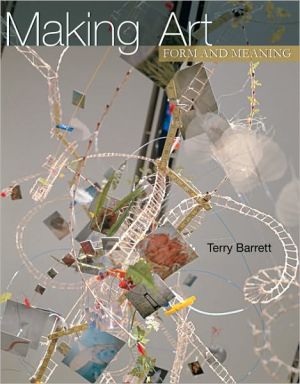

 |

|

Sold Out
Book Categories |
1 MAKING ART: AN OVERVIEWProcesses and PurposesSubject Matter and MeaningsRepresentational Works of ArtNonrepresentational Works of ArtSimple and Complex Subject MatterChoice and Use of the MediumMedium as MaterialMedium as ArtformMedium and CraftsmanshipAspects of FormContextsViewing ContextInternal ContextArtist's ContextSocial ContextArt Historical ContextConclusion: The Components and Meanings2 MEANINGS AND INTERPRETATIONSDesigning with a PurposeArchitecture: Designing for a Small SpaceProduct Design: Knowing How the Product Is PerceivedGraphic Design: Integrating Purpose, Form, and ProcessCommissioned ArtThe Value of Knowing Your Own IntentionsWriting an Artist's StatementThe Process of Interpretation: Subject Matter + Medium + Form + Contexts = Meanings Martin Puryear's Ladder for Booker T. WashingtonSubject MatterMediumFormContextsMeaningsHannah Wilke's Intra-Venus SeriesSubject MatterMediumFormContextsMeaningsJacquie Steven's Double-Spouted JarSubject MatterMediumFormContextsMeaningsAnnie Seidman's UntitledSubject MatterMediumFormContextsMeaningsSemiotic Interpretations: Denotations and Connotations"Right" InterpretationsDeciding among Competing Interpretations The Value of Having Your Work InterpretedConclusion: Principles for Interpreting Art3 POINT, LINE, SHAPE, MASS AND VOLUME, TEXTURE, AND VALUEPointLineLine in Two-Dimensional ArtLine in Three-Dimensional ArtShapeFigure and GroundPositive and Negative ShapeAmorphous ShapeThree-Dimensional ShapeMass and VolumeTextureActual TextureImplied TextureInvented TextureValueConclusion: The Power of Simple Elements4 COLORBasic Color PhysicsColor and LightAdditive Color and Subtractive ColorOptical Mixing ProcessesColor WheelsPhysical Traits of Color: Hue, Value, and IntensityNeutralsPigments and DyesOpaque and Transparent ColorsSubtractive Color MixingColor SchemesMonochromatic, Analogous, and ComplementaryTriads, Tetrads, and HexadsWarm and Cool ColorsEarth TonesPolychromatic SchemesColor InteractionsSimultaneous ContrastAfterimageArtists and Optical MixingLocal Color and Arbitrary ColorColor and MeaningMood and EmotionColors and CulturesConclusion: Beyond Color Theory5 SPACEActual SpaceThe Psychology of SpaceArchitectural SpaceInterior SpacesArtifacts within SpacesThree-Dimensional Artifacts In the RoundIn ReliefPositive and Negative SpaceVirtual SpaceVirtual Entertainment SpacesSimulated Spaces for Real-World TrainingVirtual Educational SpacesIllusional SpaceIndicators of Ilusional SpaceForeground, Middle Ground, and BackgroundSizeOverlapTransparencyPlacementTypes of PerspectiveAtmospheric PerspectiveLinear PerspectiveOne-Point PerspectiveTwo-Point PerspectiveThree-Point PerspectivePoints of ViewBird's Eye ViewWorm's Eye ViewForeshorteningIsometric PerspectiveMultiple PerspectiveDenying IllusionConclusion: Limitless Opportunities in Space6 TIME AND MOTIONIndicating Time in ArtDimensions of TimeActual TimeImplied TimeRecorded TimeIndicting Motion in ArtActual MotionImplied MotionImplied Motion and Passage of TimePhotographic Techniques in Implied MotionRecorded MotionConclusion: Perspectives on Time and Motion 7 WORDS AND SOUNDSWords and Their Uses in ArtWords as ImagesWords and ImagesSounds: Adding a Sensory DimensionAudible WordsNonverbal SoundsConclusion: Combining the Elements8 DIRECTIONAL FORCE, SIZE, SCALE, AND PROPORTIONDesign PrinciplesDirectional Force Vertical ForceHorizontal ForceDiagonal ForceCircular ForceTriangular ForceUsing Multiple Directional ForcesSize, Scale, and ProportionMaking a Statement with SizePlaying with ScaleSearching for Perfection in ProportionClassical ProportionsThe SpiralConclusion: Effective Uses of Size, Scale, and Directional Force9 BALANCE AND CONTRASTBalance and Weight: Actual and ImpliedKinds of BalanceSymmetrical BalanceApproximate Symmetrical BalanceAsymmetrical BalanceRadial BalanceAchieving Balance in ArtifactsContrastVisual ContrastConceptual ContrastConclusion: The Inherent Qualities of Balance and Contrast10 REPETITION, UNITY AND VARIETY, EMPHASIS AND SUBORDINATIONRepetitionPatternRepetition and RhythmUnity and VarietyPrinciples that UnifyGrids: Basic Structure for Unity or VarietyDesigning Works for VarietyEmphasis and SubordinationEmphasis: Focusing Viewers' AttentionSubordination: Supporting a Larger ThemeConclusion: Reflecting on Design Principles11 POSTMODERNIST APPROACHES TO MAKING ARTModernism and Postmodernism in CultureModern Art and Postmodern ArtPostmodern Attitudes toward ArtChallenging the Art WorldEscaping the Confines of Museums and Other Traditional VenuesCollapsing Boundaries between “High” and “Low” Art"Texts" and "Works"Rejecting OriginalityAccepting the AbjectJouissancePostmodern Strategies for Making ArtWorking CollaborativelyAppropriating What Already ExistsSimulating the "Real"Hybridizing Cultural InfluencesMixing MediaLayering ImagesMixing CodesRecontextualizing the FamiliarIntertextualizing SignsConfronting the GazeUsing DissonanceConstructing New IdentitiesAdapting Literary Devices to Visual ArtUsing NarrativesCreating MetaphorsUsing Irony and ParodyConclusion: Are You a Postmodernist?12 ARTISTS' PROCESSES AND PRACTICESArtists' Motivations and Ideas for Making ArtArtists' Practices of Making ArtConclusion: Keep Yourself Motivated13 STUDIO CRITIQUESCritiques DefinedRecommended Attitudes toward CritiquesWhat Students Want and Do Not Want from a CritiqueKinds of CritiqueDescriptive CritiquesIntentionalist CritiquesInterpretive CritiquesJudgmental CritiquesTheoretical CritiquesSamples of CritiquesExcerpts from an Interpretive CritiqueA Written CritiqueAssessing Your Own ArtConclusion: The Benefits of CritiquesNotesGlossaryBibliographyPhoto CreditsIndex
Login|Complaints|Blog|Games|Digital Media|Souls|Obituary|Contact Us|FAQ
CAN'T FIND WHAT YOU'RE LOOKING FOR? CLICK HERE!!! X
 You must be logged in to add to WishlistX
 This item is in your Wish ListX
 This item is in your CollectionMaking Art: Form and Meaning
X
 This Item is in Your InventoryMaking Art: Form and Meaning
X
 You must be logged in to review the productsX
 X
 X

Add Making Art: Form and Meaning, This comprehensive introduction to art and design explores making artifacts as a process of making meaning. Making Art: Form and Meaning offers a framework for understanding how all the aspects of an artwork—subject matter, medium, form, process, a, Making Art: Form and Meaning to the inventory that you are selling on WonderClubX
 X

Add Making Art: Form and Meaning, This comprehensive introduction to art and design explores making artifacts as a process of making meaning. Making Art: Form and Meaning offers a framework for understanding how all the aspects of an artwork—subject matter, medium, form, process, a, Making Art: Form and Meaning to your collection on WonderClub |